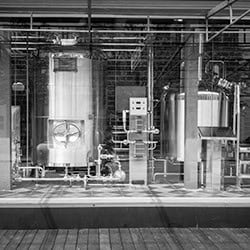Case Study: Lead Paint Removal in Ontario Brewery
 Until as late as 1980, it was common practice to add lead to paint. The heavy metal made paint dry quickly, increased durability and moisture resistance, and produced a distinct pigment.
Until as late as 1980, it was common practice to add lead to paint. The heavy metal made paint dry quickly, increased durability and moisture resistance, and produced a distinct pigment.
It also protected against corrosion, and for this reason, lead paint was extensively used on structural steel.
Once the discovery was made that lead paint causes serious illness and is particularly dangerous for young children, regulations started coming into place, eventually banning the use of the substance indoors.
Today, lead paint is still found in older homes, buildings, and industrial structures, and must be removed with great care. Health Canada warns removing, repairing, or disturbing this paint can result in lead poisoning and/or brain and nervous system damage.
Recently, owners of a brewery in Ontario were planning to modify their production equipment. As part of the project, they wanted to demolish a section of the old brewery and install new structural steel. Before they could proceed, however, they first had to find a way to remove the lead paint that coated the existing structural steel.
Wickens Dry Ice Blasting was hired for the project because of the company’s extensive experience and success in removing lead paint from industrial, commercial, and residential buildings.
Following lead paint removal protocol, Wickens began by setting up a full containment zone around the site where the steel was to be replaced so that adjacent areas and brewery equipment wouldn’t be affected by the remediation works.
A strict dust-free process was followed throughout the project, with special tools used to safely remove the lead paint as soon as it was detached from the surface without creating dust. The meticulous process that Wickens employed eliminated the risk of lead paint particles escaping into the air and contaminating the environment.
After the removal process was applied to each area, independent testing was carried out to verify that the surfaces were free of lead paint. The entire work area was then thoroughly cleaned using a two-step process that ensured any lead paint residue was also removed.
The final step in the removal process involved the safe disposal of the lead waste. Contaminated material was collected and secured in special containers for safe transportation and disposal.
Wickens’ processes significantly minimized downtime for the brewery. The project was completed in one week, within budget, and the owners of the brewery were able to carry on with their equipment modification project without fear of lead paint exposure.
If you have a lead paint that needs removing, we can help. Contact us for more information or a free quote today.
- Why You Need an Air Preparation Unit for Dry Ice Blasting - May 13, 2024
- Happy Holidays from Wickens - December 20, 2023
- Maximize Your Year-End Shutdown: The Ideal Time for Industrial Cleaning with Dry Ice Blasting - November 24, 2023
